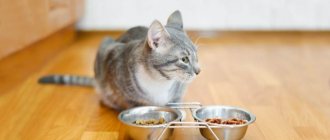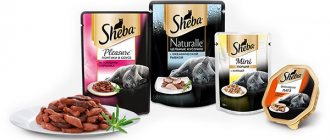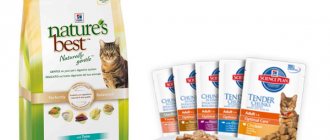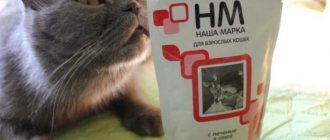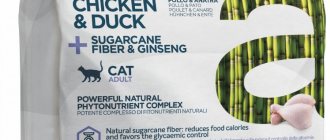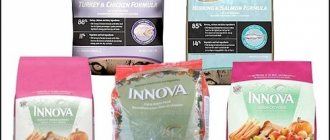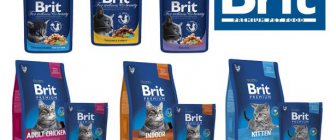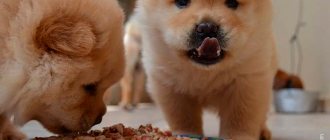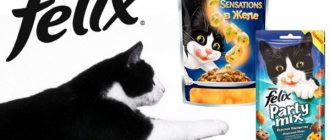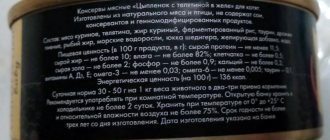Properly selected dry food for kittens is the key to the health and development of a pet, regardless of gender, age and breed (be it Scottish Fold, Maine Coon, Sphynx, Bengal, etc.). Newborn animals refuse mother's milk and switch to adult food at about 2 months. By this time, caring owners should create a diet that will be beneficial and not harmful.
Rating of the best dry food for kittens
From the author: almost all food, even high-end ones, contain rice or potatoes, and sometimes both, as a carbohydrate component. In general, this is not so bad, especially when the manufacturer specifies that it is yam (sweet potato), whole brown or white rice. True, the use of the latter is preferable, and the best feeds add vegetables as carbohydrates. Cereals, such as corn or wheat gluten, flour from these products, etc., are highly not recommended for cats and kittens. should alert the owner.
List of the best solid foods for pets up to a year old (you can click on the photo of the composition to enlarge it):
| Name | Description, composition on packaging, granules |
| Orijen Cat & Kitten | Made in Canada. Considered the best holistic practitioner. There are no grains, potatoes, or rice. 85% are sources of protein, 15% are carbohydrates. The first ones used are fresh chicken, turkey, fish, and offal. The second are red and green lentils, green and yellow peas, chickpeas, beans, whole navy beans, pumpkin, etc. Calorie content: 416 kcal per 100 g. Feed costs from 800 to 1500 rubles. per kg depending on packaging. |
| Applaws Kitten Chicken Grain Free | Made in the UK. The manufacturer lists potatoes in third place in the composition, but we still put this food in second place, since the first places indicate 62% chicken meat and 17% minced chicken meat (note, not minced chicken, which could mean that there is a lot of skin there). Calorie content: 380 kcal per 100 g. The food has a fairly reasonable price; it costs almost twice as much as Orijen, namely about 420 rubles. per kg when purchasing the largest package. |
| Meowing Heads Smitten Kitten for kittens with chicken and rice | Another British product. Has earned popularity among breeders of elite cat breeds. Contains 70% chicken, fish and eggs, brown rice, oats. Calorie content: 408 Kcal per 100 g. The food contains no additives that can provoke an allergic reaction (corn, dyes, etc.). The price of the products is high, but the quality matches it, namely about 950-1000 rubles. per kg. |
| Canagan Free-Run Chicken, Scottish Salmon, Country Game Canagan Free-Run Chicken Canagan Scottish Salmon Canagan Country Game | The food has not yet received great popularity, because... British manufacturer has recently entered the market. There is no special line for kittens because the diet is suitable for all ages. There are no grains in the composition, they are replaced by potatoes. It is worth noting that if potatoes or sweet potatoes (sweet new ones) are among the first 5 ingredients, as in this food, it is believed that the manufacturer is using it more as a cheap filler rather than a source of fiber that kittens need. However, the rest of the food composition is not bad. Here are the first components of the chicken flavor: chicken meal occupies 35.5%, fresh boneless chicken fillet 25%, followed by sweet potatoes and potatoes, 4.2% chicken fat, 4% eggs, 2.3% chicken broth, 1. 2% salmon oil, minerals, vitamins, etc. The feed is 90% digestible, thanks to this there will be a minimal amount of excrement. Calorie content is not indicated by the manufacturer. It is more profitable to take large packages weighing 4 kg, then the food will cost from 850 to 950 rubles. per kg, otherwise it will cost more than 1000 rubles.
|
| Grandorf Lamb & Rice Kitten | Country of origin: Belgium. There is only one type available for kittens. The products contain a large amount of proteins, are hypoallergenic, strengthen the immune system, and relieve problems with hair and teeth. Unfortunately, the manufacturer does not specify the percentage of protein components. But dehydrated lamb and turkey come in first and second place, and whole white rice comes in third. Calorie content: 449 kcal per 100 g. When purchasing a two-kilogram package, a kg of feed will cost 750 rubles. |
| Pronature Holistic Kitten Chicken & Sweet Potato | Feed made in Canada. Instead of wheat, it contains rice and sweet potatoes. At the beginning are whole and dehydrated chicken, 19% each, chicken fat and herring flour. Calorie content: 424 kcal per 100 g. A kg of feed when purchasing the largest package will cost from 700 to 750 rubles. |
| Farmina N&D Kitten Chicken & Pomegranate Grain Free | The food is produced in Italy and Serbia. It consists of 70% protein, and 30% vegetables and fruits. In third place in the composition is potatoes after 30% fresh boneless chicken and 28% dehydrated. Product absorption occurs at 80-90%. Calorie content: 393 kcal per 100 g. Feed per kg when buying a large package will cost from 600 to 800 rubles, if you buy a small one, 1.5 kg, then 1000 rubles. |
| 1st Choice Kitten Healthy Start Chicken | The food is produced in Canada. In third place in the composition is rice, and the manufacturer does not specify which one, which makes us wary. But in any case, it is better than cereals. In first and second place are 17% fresh chicken and the same amount of flour from this bird. Calorie content: 376.2 kcal per 100 g. Buying a 5 kg package of food will cost about 630 rubles. per kg. |
| Fitmin Cat Purity Kitten | Czech manufacturer. There are some questions about the composition, the meat is indicated at the beginning, of which 44% chicken, 19% pork liver, 8% duck, 5.6% fish, 1.7% pork and beef. It is not clear what kind of meat takes up another 21.7%. Next comes chicken fat. Farm potatoes and green peas are used as the main carbohydrates. The composition includes substances that eliminate the unpleasant odor of excrement. Calorie content: 430 kcal per 100 g. The food costs 580 rubles. per kg when purchasing a package of 10 kg. 850-1000 rubles if you buy a small one. |
| Brit Care Crazy I'm Kitten | Manufacturer from the Czech Republic. The ingredients include rice and rice bran in third and fifth place respectively. It is a pity that the manufacturer does not specify what kind of rice is used. In first place are high-quality sources of protein, 25% dehydrated chicken and 22% fillet, in fourth place is chicken fat. In general, the food is quite suitable for feeding kittens. But one of the reviews that we analyzed indicated that, judging by the taste, the granules contain corn, which the manufacturer does not mention. Believe it or not, it's up to you. You can try the food and then watch your pet’s reaction. It is also worth considering that this food is not suitable for all animals. Some pets refuse it and lose weight because of this. Therefore, before completely switching to it, you need to test it for a few weeks first. This composition is unpopular with many breeders due to its low taste and low nutritional value. Calorie content: 440 kcal per 100 g. The food is not very expensive, from 400-450 rubles. per kg when purchasing a package of 7 kg. |
| Karmy Kitten Turkey | Not a bad composition for premium food. These are domestic products. The range is constantly expanding, which indicates its demand. The composition is well balanced, containing seaweed and vitamin E. There are also elements that block the unpleasant odor of feces. 41% is turkey meat, whole white and brown rice are used as carbohydrates. There is a lack of some macro- and microelements necessary for each kitten individually. Therefore, the veterinarian may prescribe additional vitamin and mineral complexes. The food has a mild aroma, which makes storage easy. But many people talk about the inconvenience of packaging. Calorie content: 408 kcal per 100 g. The food will cost only 380 rubles. per kg when purchasing a package of 10 kg. But even if you buy a small one, 1.5 kg, it will cost from 500 to 550 rubles, which is quite acceptable. |
| Probalance Kitten 1st Diet | We will put this food in last place in our rating. Overall, for a premium product its composition is not that bad. In any case, it is much better than Royal Canin, which we will talk about below. The food is produced by a Danish company. There are also factories in Russia. In first place with 32% poultry meat, followed by rice, barley, beet pulp, oats, and peas. There are a lot of carbohydrates, but they are not the worst. So, barley is the best of all grains in finished feed, of course, we could do without it, but its use is preferable to wheat, corn, rye and even oats. Beet pulp is a good source of fiber, oats, as we have already said, are better than other grains, and peas are also a good ingredient. However, 32% of the bird is not enough for a growing kitten, and it is not specified what kind of bird it is, and it is also not clear what kind of rice is used. So consult your veterinarian before switching your kitten to this food. Calorie content: 385 kcal per 100 g. The price of food is not at all high, a kg will cost only 185 rubles. when purchasing a large package. |
You should not skimp on pet food. Especially on food for kittens, whose bodies are still developing. The health of the animal depends on a properly selected diet. In addition, expensive food is more nutritious; less quantity is needed to keep your pet satisfied. Along with the dry diet, you can also give canned food for kittens.
What should protein be like?
The quality and type of meat are important, as is the quantity. To obtain a full set of vital amino acids, a predator needs a varied diet: beef, pork, poultry, rabbit, eggs, fish, offal. For example, in the composition of the holistic Fitmin Cat For Life Hairball we see: chicken meat, eggs, pork liver, fish.
In cheap feeds, high-quality animal products are replaced with bone meal and grain, so caring owners are increasingly choosing premium lines and holistic feeds (the highest class of feeds). It is more expensive, but when you factor in the costs of veterinarians and medications that are inevitable with poor nutrition, the difference is not too great.
Dry food for kittens that we do not recommend for daily feeding
| Name | Description |
| Hill's Science Plan Healthy Development | The composition is not the worst, there is quite a lot of high-quality protein, namely chicken and turkey flour. But in third place is corn. Corn protein is even less digestible by cats than wheat protein, only 54%. Moreover, pets get only 20-35% of their energy from carbohydrates; they get more than 40% of it from proteins. Therefore, corn should definitely not be the basis of a cat or kitten’s diet. |
| Josera Kitten | The composition, in addition to duck and turkey flour and duck fat, contains corn, rice and corn gluten. |
| Purina One for kittens | The composition is far from ideal. True, 17% chicken comes first, but even here we cannot be sure that this is meat, because... no specifications, followed by dried poultry protein, 14% whole wheat, animal fat, wheat and corn gluten, soy flour, pea protein concentrate, corn starch, dried chicory root, corn, etc. There is also no information on the percentage of components. |
| ProPlan Junior and Kitten | Contains corn and wheat gluten, rice, corn. In first and second place are 20% chicken and dried poultry protein. |
| Royal Canin | After the food was bought by the Mars company and it began to be produced in Russia instead of France, its quality dropped significantly. In other words, its composition is now very similar to economy, despite the presence of different lines, for example, for kittens there is a special milk replacer, food from 1 to 4 months, from 4 months to a year and for sterilized small cats. For example, the first ingredients in MOTHER&BABYCAT food are: dehydrated animal proteins (poultry), animal fats, rice, vegetable protein isolate, grain flour. So, nowhere is there any clarification about what kind of poultry is used, whether it is meat, what kind of rice, what vegetable protein is obtained from, what kind of grain. In general, the composition leaves much to be desired. |
| Cat Chow Kitten | The food is popular due to its affordable price. Reviews from cat owners are mostly positive, however, there are cases where the products provoked an allergic reaction. The composition contains a minimal amount of vitamins and minerals, so the kitten receives few useful elements. In addition, cereals come first. The diet does not contain harmful chemicals, dyes, or artificial flavors, so this is one of the best options among the economy segment, but you should not feed it on an ongoing basis. |
| Whiskas for kittens delicious pads with milk, turkey and carrots | Is a budget option. In the first place in the composition are wheat flour, poultry meal, turkey meal, meat and bone meal, rice, protein plant extracts, etc. The food cannot be used for daily feeding. |
Types of dry food
It is very convenient to feed pets with dry food. It saves time, does not require special storage conditions and additional mineral and vitamin complexes. The food is completely balanced, kittens receive all the necessary substances from it. However, not all ready-made diets available on store shelves are of high quality. It is not recommended to feed cats of any age with advertised, cheap products. It contains ingredients of dubious quality.
All cat food is divided into classes:
- Holistics are the best choice for small pets, sterilized cats, and weakened animals. They consist only of high-quality natural ingredients suitable even for human nutrition. The composition includes a huge amount of minerals and vitamins, beneficial plant components.
- Super premium - slightly inferior in composition to the previous type of food, but suitable for kittens.
- Premium - cheaper than holistic products and super premium products. Accordingly, the quality of raw materials is lower. This food can be fed to kittens, but not daily.
- Economy - not recommended for consumption. Such diets consist of low-quality by-products, cheap cereal additives, artificial flavor enhancers and other elements harmful to the growing body.
Diets are divided depending on the age of the kitten:
- up to 12 weeks;
- up to 10 months (for some manufacturers up to 1 year).
Although kittens can start eating a full diet at two months of age, experts recommend feeding dry food starting at 8 months unless there is a particular need for it.
Protein is an essential element of cat nutrition.
Protein is an essential nutrient, a chronic deficiency of which can lead to irreversible health problems for your pet. This is the main building material for the body, a source of energy. Proteins are composed of amino acids, most of them are essential (taurine, histidine, methionine, arginine, valine, leucine, lysine, tryptophan, isoleucine, phenylalanine, threonine). They are not synthesized from other substances, so they must come from food.
The main food for predators is provided by animal protein, which contains the entire set of amino acids that cannot be reproduced by the body. It is impossible to completely replace meat with protein-containing plant products (for example, legumes). Cats will not get all the nutrients they need from them.
It is especially important for kittens, pregnant and lactating cats to comply with the physiological norm of animal protein consumption. A significant reduction in the protein diet provokes growth cessation, loss of body weight up to critical, fragility, and brittle bones.
Mr. Cat recommends: the benefits of dry food for kittens
Such products have the following advantages:
- simplicity and ease of use and storage;
- availability (can be purchased at any pet store, online);
- balanced composition (of course, you can independently calculate the proportion of substances necessary for a growing kitten, but it’s easier to purchase dry products);
- the content of a beneficial amino acid - taurine, which enters the body only with food (it is not produced naturally; with its deficiency, problems with the activity of the brain and heart begin, and vision deteriorates).
About soaking dry food
If you start giving dry food to a kitten at the age of 2-2.5 months, it is pre-soaked. This is necessary to make it easier for small pets to chew the granules.
If the kitten swallows the food whole, it may choke. In addition, his gastrointestinal tract cannot yet digest solid food well. Because of this, ulcers, gastritis and other diseases of the digestive system develop. Hard food components cannot completely dissolve in the pet’s stomach. This provokes acute intoxication, poisoning and other serious disorders.
In some cases, food needs to be soaked even at a more mature age:
- if it is necessary to switch from natural food to finished products;
- if the animal has a sensitive digestive system;
- during the period of change of milk teeth due to dental problems;
- When a pet vomits after solid food, particles of undigested granules are observed in the masses.
Read about feeding cats and kittens natural food.
Step-by-step soaking of feed:
- Boil water and cool to +55…+70 °C. The smaller the granules, the cooler the liquid. Steep boiling water cannot be used, because... the products will lose their nutritional value. If the water is too cold, the food will soak for a very long time. You can also soak the prepared diet in milk. It must be boiled, warm, pasteurized. If the fat content is high, it can be diluted with water. Please note that not all feed can be diluted with it. Substances contained in milk are antagonists that enter into a chemical reaction. Because of this, dry granules lose some of their beneficial elements.
- Pour the required amount of food intended specifically for kittens into a bowl and add water so that the granules are completely immersed in it. The daily dosage of the diet is indicated on the packaging. For a baby, it averages 100-110 g. The pet should not be overfed, as this can lead to obesity and other health problems.
- Cover the bowl with a lid or saucer.
- When the granules swell (after about 10-20 minutes), mix them thoroughly. Break up the lumps with a fork.
- Cool, but be careful not to let food get too cold.
Soaked food spoils quickly and can be stored for no more than half an hour, especially at high temperatures and humidity. If you do not take this into account and give your pet spoiled food, this risks poisoning, accompanied by diarrhea, bloating, flatulence, loss of appetite, and lethargy.
In addition, soaked granules quickly lose their smell and taste. Therefore, the kitten may refuse them. Food must be prepared specially before each feeding. To ensure that there are no pellets left, you need to cook as much as your pet can eat at a time.
Also read: the best dry food for adult cats.
How much should you limit protein and phosphorus?
There is still no clear conclusion on the optimal amount of animal protein consumed for kidney disease. The situation is complicated by the lack of large-scale studies that would give reliable results. Experts are discussing this issue, but general recommendations have been established: therapeutic diets have been developed for different stages of CKD. Their protein content is reduced to 58 - 82 g of protein per 1000 kcal for cats. When making calculations, the doctor must take into account the patient’s condition and make adjustments based on diet tolerance.
The phosphorus content in therapeutic diets should not exceed 1.35 g per 1000 kcal. In this case, it is necessary to monitor blood plasma parameters. If, through dietary restriction, it is not possible to achieve normal concentrations, hyperphosphatemia persists (0.9-1.5 mmol/l in the second stage of CKD and 1.6-1.9 mmol/l in the third), it is necessary to add drugs that bind phosphorus in the intestines.
All medications must be prescribed by a doctor based on test results.
If the animal is undergoing treatment, then it is necessary to monitor the response to complex therapy. This will allow you to correctly assess his condition and, if necessary, optimize the nutrition process and the doses of medications taken. When improvements occur, the diet cannot be stopped. If chronic renal failure is already an established fact, then your doctor will recommend that you completely switch your pet to premium low-protein cat food.

